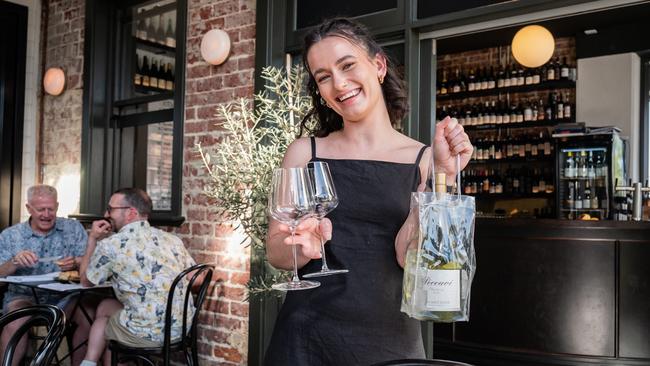Drink up: end in sight for waiting hand and foot
In Perth come dusk customers start trickling through the doors, find somewhere to sit, and then head to the bar to order drinks, food, or probably, both.

On a gentrified inner-city corner of old Perth come dusk, customers start trickling through the doors, find somewhere to sit, and then head to the bar to order drinks, food, or probably both.
The folks behind the counter hand over water, good glasses, wine bottles and cutlery, and the happy customer ferries it all back to base-camp. It’s a not unfamiliar transaction.
But no, it’s not a pub. And it’s more likely to be housemade charcuterie with a Frankland River syrah than parmys and schooners.
It might just be, however, the future of dining in a climate of acute labour shortage across many sectors, none so great as the hospitality industry.
“It’s a timely conversation, and it doesn’t just pertain to hospitality,” says Vincent Wine’s Dru Daniels.
“My inspiration was always places in Paris where the focus is on produce and wine, not fussy service. Places where the waiters are really just plate-running. The way we do it allows us to operate with just one team, which is great for cohesion among the group.”
And then the kicker.
“If you don’t get your labour costs right in hospitality, you might as well not do it,” he says.
Isolated from the lockdown woes of the eastern states, Perth in particular has seen a slew of low service/high food and wine bar/restaurants open across the city over the past 18 months.
The staff crisis in hospitality existed well before Covid.
If there’s a way of making money with a smaller wages bill, operators are more than interested. The rhetoric is easy enough to swallow: lower wage bills, with an element of DIY for the patron, mean more affordable eating out.
But in many cases, there’s not much option.
“East End Cellars, the bottle shop that could,” says Adelaide wine writer and show judge Nick Ryan, “went from wine types opening bottles at the front counter … to a scattering of tables doing the usual charcuterie riff … to stepping it up properly with (chefs) Georgie Rogers and now Josh Lansley.
“Where once I only went to drink, now I’m just as interested in what I’ll eat …. we take in turns in picking a bottle …. not getting lost in the pages of a list, but up off the seat, perusing the shelves.”
East End Cellars proprietor Michael Andrewartha says he puts his resources into the staff behind the bar and in the kitchen, not the floor.
“People who can run a floor are unique individuals,” he says, “and even if I wanted to go down that route, I can’t find them in Adelaide. Too many have left the industry; they’re talented people who have found work elsewhere.”
According to industry body Restaurant and Catering Australia, between December 2019 and May 2021 more than 660,000 temporary visa holders left Australia, many of them restaurant workers.
Needless to say RCA wants the federal government to fast-track their return and make up the shortfall with a path to visa permanency. It says there are tens of thousands of unfilled vacancies across Australia, ranging from barista to head chef.
“Any service model where I can take people off the floor is good,” says one of Adelaide’s most innovative and fecund restaurateurs, Simon Kardachi.
“All my businesses need to sell drinks … Typically my restaurants run at around 65 per cent food to 35 per cent beverages, but a model that can sustain a shorter menu with figures closer to 50-50, reducing wages in the kitchen and on the floor, is the holy grail.”
Kardachi’s latest project, Shomen, a ramen bar in the city’s heart, offers counter ordering with waiters running orders “and it’s been very successful”, he says. “But we offer table service for drinks to get the spend up.”
He predicts shorter allocated times for tables, suggesting the two hours we may have become used to will move to 90 minutes, maybe less.
“That’s got to be the way people go with new openings,” believes Sydney wine bar veteran Stuart Knox of Fix Wine in Elizabeth St. “If I was rebuilding my business today from scratch it’s exactly how I’d do it. A great long bar down the middle and no wait staff. In 2022 we will see a slew of them.”
Already one of the legacies of enforced social distancing that seems destined to stay, in many venues, is the contactless QR system of ordering from the table with a mobile.
Increasingly, says Me&U’s Stevan Premutico, the system is finding its way into the kinds of venues that, in the past, relied on waiters to take orders and sell. He says the industry is rethinking the role of the front of house team; rapidly shifting from order/payment takers to more focus on customer experience. “Venues are able to open sections they would previously had closed because they couldn’t staff it,” he says. “And they can open days they would previously have had to close.”



To join the conversation, please log in. Don't have an account? Register
Join the conversation, you are commenting as Logout